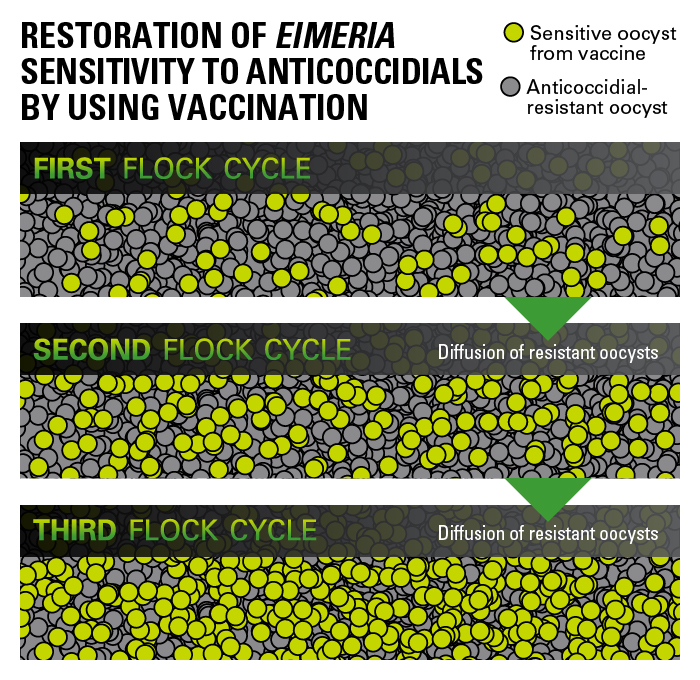“Vaccines are a way to maintain the efficacy of anticoccidials in the long term. I think it’s sustainable for the time being,” Finklin said, adding that vaccines administered must target the three common Eimeria species — E. maxima, E. acervuline or E. tenella — to be fully effective. “Producers are becoming more satisfied with the performance of vaccines by themselves and have started using them as a mainstay in their coccidiosis control programs.”
Of the three primary species, E. maxima is the one most commonly referred to as a major “performance robber” in U.S. broiler facilities today. Infection can happen both clinically and sub-clinically; while the former causes symptoms like intestinal hemorrhaging, the latter is often only diagnosed via an intestinal scraping during necropsy. E. maxima is also the highest-priority species because of its increased likelihood of ushering in damaging secondary issues.
“This particular species invades a lot deeper, and it gets into the middle part of the intestine, where a good amount of nutrient absorption is going on. It takes very little E. maxima to cause you performance loss. And that’s why when we go and evaluate a farm’s coccidiosis program to see if it’s working, the E. maxima is the one we look for in conducting an intestinal scraping. You may not see it with the naked eye, but you can see it under a microscope,” Finklin said. “The E. maxima is a key Eimeria tied to intestinal damage leading to diseases like necrotic enteritis, which is another significant problem for poultry producers. By reducing E. maxima, you can manage secondary bacterial challenges that can lead to significant mortality.”
Add VANNIX C4 to Combat Enteric Challenges
Some bio-shuttle treatment programs — those that combine anticoccidial chemicals, vaccines and other products like VANNIX C4 — often include a direct-fed microbial (DFM) as a way to ease symptoms of a potentially damaging case of coccidiosis or phytogenic ingredients – tannins, saponins, essential oils, etc. – that help promote better intestinal health. Regardless of the combination of products administered, producers should prioritize the natural cycling of any coccidiosis present in the environment.
Herein lies the benefit of VANNIX C4; the combination of phytogenic ingredients, including a novel hydrolysable tannin, and the probiotic Bacillus subtilis, PB6 helps ease the impact of any enteric challenges created by coccidiosis in a bird’s system, while helping sustain the normal cycling timeframe for whatever cocci are present. Such a combination of phytogenics and probiotics yields strong protection from secondary infections like necrotic enteritis, making it a natural, effective addition to any coccidiosis vaccination or coccidiosis bio-shuttle treatment program.
“You want to attack the coccidiosis part of it, because that’s partly why we get necrotic enteritis. We know it helps with coccidiosis directly. The thing on top of that that makes VANNIX C4 different from most competitors is that others just have a phytogenic, such as an essential oil, that’s going to help with the coccidiosis. But VANNIX C4 also has the PB6 probiotic in it, and that will help control Clostridium perfringens, the bacteria that causes necrotic enteritis. You wind up with a multi-faceted approach to controlling necrotic enteritis,” Finklin said. “There are pros and cons to vaccination: It helps improve birds’ immunity to disease and sustains efficacy of anticoccidials for coccidiosis. But, one con is the continued likelihood of bacterial enteritis. That’s where VANNIX C4 helps. It can help vaccines work without impacting how coccidiosis cycles. And, you’re adding a helpful probiotic.”
Given the benefits of VANNIX C4 as an addition to any coccidiosis control program for broilers, the product can provide producers added confidence of the overall efficacy of a vaccine-based prevention program for both the parasitic disease and costly secondary infections. In addition to providing essential compounds that complement the bird’s ability to stave off coccidiosis damage, it also delivers consistency in coccidiosis cycling, enabling other products — anticoccidials or vaccines — to continue to function optimally.





